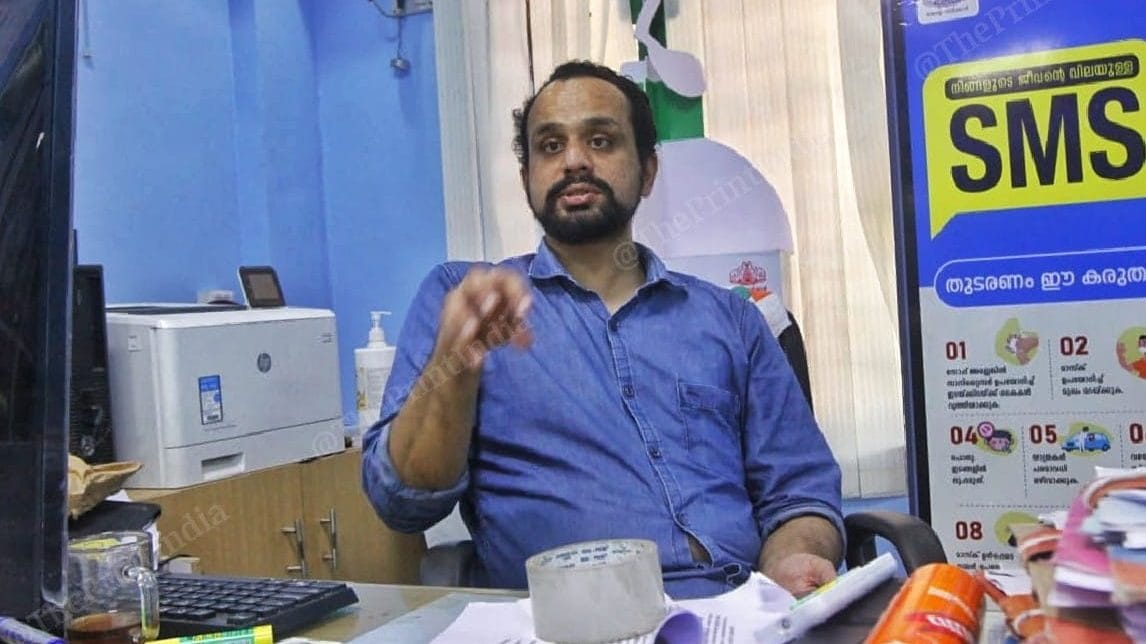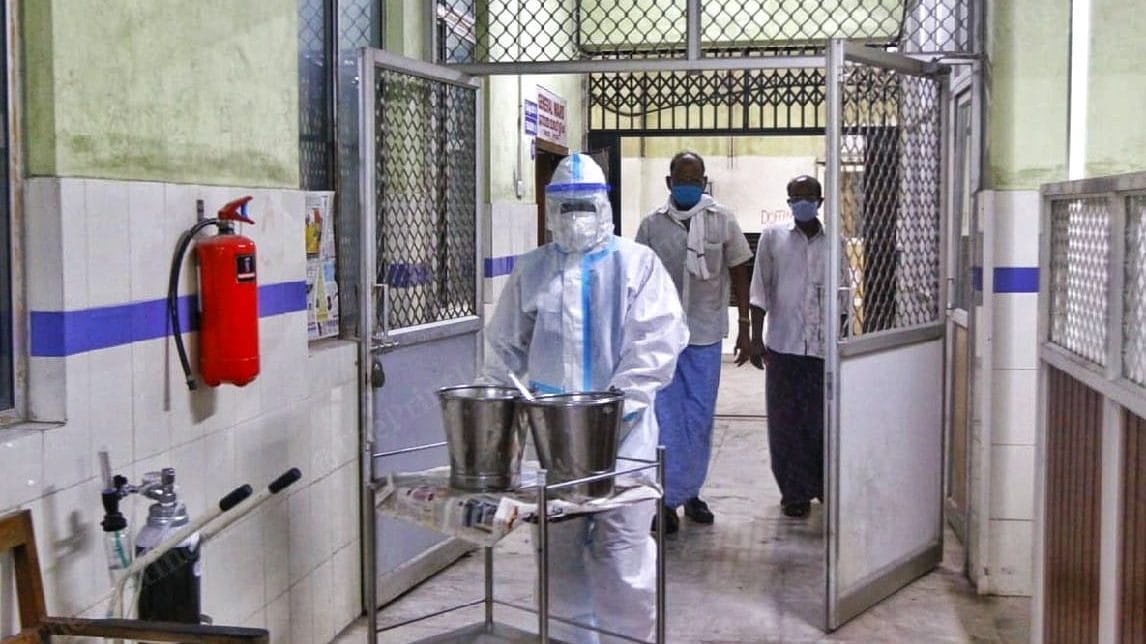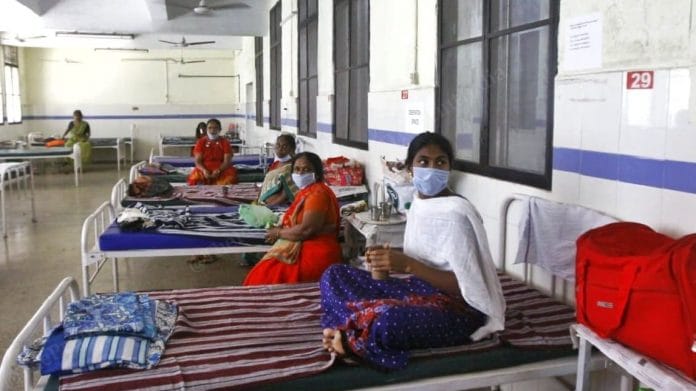Thiruvananthapuram: There are tell-tale signs all over.
The Covid-19 first-level care centre at the Government Homoeopathic Medical College in Iranimuttom, like many others, was turned into a second-level care centre about a month ago. Chief Minister Pinarayi Vijayan’s daily Covid briefing has moved online, as have the weekly cabinet meetings. By 8.30 pm, the city starts to resemble a ghost town due to the prohibitory orders and the early closing deadline for business establishments.
And while boards of the once “successful” ‘Break the Chain’ campaign — which won the state global accolades — still dot the city, they are discoloured now.
Welcome to Thiruvananthapuram, the capital of Kerala and one of the worst epicentres of the current resurgence of the pandemic in the state.
Of the 884 deaths in the state so far (4 October), over a quarter or 266 have been in Thiruvananthapuram. The capital has also reported 40,290 cases — about a sixth of the total 2,29,886 cases in the state.
The positivity rate over the past two weeks in Thiruvananthapuram has been in the 17-18 per cent range as compared to the state average of about 13 per cent.
The numbers are in line with the spurt in cases that Kerala is witnessing.
From being the country’s poster boy of Covid-19 management, Kerala has of late had the highest increase in cases.
As of 4 October, the state had recorded a total of 2,29,886 cases, of which 52,566 cases were reported between 28 September and 2 October.
This is a far cry from 4 May when the state, which has seen the pandemic for the longest time, had reported just two deaths. Kerala is where the first case of Covid-19 was first reported in January, when a student tested positive after returning from Wuhan.
Dr Mohammed Asheel, executive director of the Kerala Social Security Mission and member of Health Minister K.K. Shailaja’s core Covid-19 team, explains Thiruvananthapuram’s status as one of the hotspots in the state by drawing parallels with Bengaluru.
He says it is the “centripetal effect” of a capital city that has caused the problem. “People converge from all over the country and the state, there are a lot of unidentified people who come in for business, to visit the secretariat,” he says.

Political protests fanned the fire
That the spurt has happened after the Onam festival, which ended 22 September, is a matter of record. In fact, Chief Minister Vijayan had actually warned about a post-Onam spike. But top government officials also blame increased political activity and a flurry of protests over the gold smuggling issue for the rise in cases.
“Elections will come next year and so there is a lot of political activity. Sometimes people forget in the heat of the moment that nobody is sacrosanct, the virus doesn’t recognise a party,” says Chief Secretary Dr Vishwas Mehta. “When it becomes a law and order issue, protocol gets compromised. Finally the CM called all political parties and said that with numbers going up can we keep it on the fence. I am glad most people agreed. If there’s a scuffle some pushing around… I have had police officers, MLAs, ministers testing positive. There is no escape from this.”
Currently, mask compliance is almost 100 per cent on the streets of Thiruvananthapuram. And in places like the Pothis mall, shop owners are extremely vigilant about not allowing more than five people in.
But the disease does seem to have gotten the better of the state that was once credited with defeating it. With Section 144 in place, there are no crowds anywhere and shops have begun closing early. There is a threat of lockdown looming in the air though the chief secretary is clear that it is not an option.
Also read: Kerala added over 1 lakh Covid cases in Sept, has highest percentage of active cases now
Upfront about community transmission
While the central government has so far shied away from declaring community transmission in the country that has so far seen 66,85,082 cases, Kerala is upfront about it.
“If you ask me, there is community transmission all across India. There is nothing bad about it, nothing to feel shy about the word. That’s the natural course of a disease,” says Dr Asheel. “When we followed a strong containment strategy, it was to contain the disease. We wanted to restrict it to local transmission. But we have accepted there was community transmission in Poonthura. There is a definition — when there are multiple independent clusters, it is indicative of community transmission. That is happening across the nation…”
Poonthura is a coastal area in Thiruvananthapuram inhabited by the fishing community where a lot of fishing trucks come in and compliance levels in the population are not very high. Some say this is because the trust in the government, irrespective of the party in power is not very high.
“Our problem (in Thiruvananthapuram) started with coastal areas. There are a lot of fish-related trucks from Tamil Nadu etc and we found they were a prime source,” says Dr Mehta. “People in coastal areas are very closed communities, conservative people. They live together. Their health is very good. But no matter what you say they don’t care… When we told them to take care of elderly, they didn’t take it seriously initially.”
Health staff unrest
There are now increasing concerns about the sufficiency of the health infrastructure, but more particularly the manpower. A doctors’ strike has just been called off after assurances from Health Minister K.K. Shailaja. Salaries are uncertain and tempers are beginning to fray.
Government officials, in off-the-record conversations, also talk about the problem of not too many private hospitals being roped in for the Covid fight, increasing the pressure on an already overworked public system.
At the Iranimuttom treatment centre, Sister Mini, who is the nurse in-charge of the 68-bed centre that was set up in June to cater to asymptomatic patients, talks about how the earlier rule of 10-day duty followed by seven-day quarantine has been discontinued. They get only a day for quarantine now.

Mini stays in a hostel on the campus, comes to work at 7.30 am and leaves at 6.30 pm. “This was a first-line treatment centre about a month back. As the cases started going up and too many people with comorbidities started coming in, it was converted to a second-line treatment centre where we get patients with mild symptoms,” she says. “We also have oxygen beds but we do not have ICU, which is why there is an ambulance here at all times to quickly shift patients who need to be shifted.”
The conversion happened because as the cases started rising, Kerala revised its policy of getting all patients to a centre like this. It now allows those without symptoms or comorbidities to stay at home and recuperate, subject to the availability of some facilities at their disposal.
Also read: How a Mujahid group in Kerala is treating the terminally ill with Islamic dawa and activism






